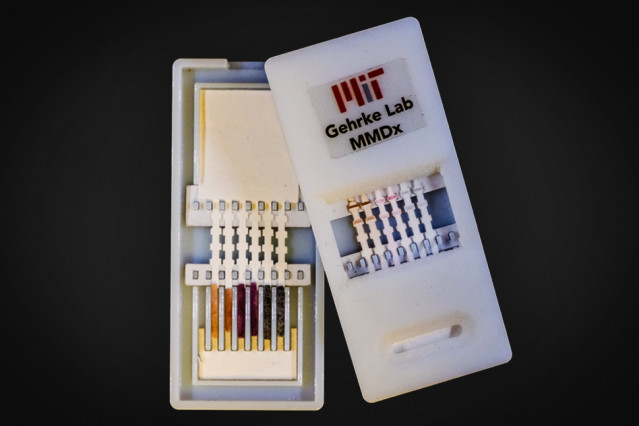
When diagnosing a case of Ebola, time is of the essence. However, existing diagnostic tests take at least a day or two to yield results, preventing health care workers from quickly determining whether a patient needs immediate treatment and isolation.
A new test from MIT researchers could change that: The device, a simple paper strip similar to a pregnancy test, can rapidly diagnose Ebola, as well as other viral hemorrhagic fevers such as yellow fever and dengue fever.
“As we saw with the recent Ebola outbreak, sometimes people present with symptoms and it’s not clear what they have,” says Kimberly Hamad-Schifferli, a visiting scientist in MIT’s Department of Mechanical Engineering and a member of the technical staff at MIT’s Lincoln Laboratory. “We wanted to come up with a rapid diagnostic that could differentiate between different diseases.”
Hamad-Schifferli and Lee Gehrke, the Hermann L.F. von Helmholtz Professor in MIT’s Institute for Medical Engineering and Science (IMES), are the senior authors of a paper describing the new device in the journal Lab on a Chip. The paper’s lead author is IMES postdoc Chun-Wan Yen, and other authors are graduate student Helena de Puig, IMES postdoc Justina Tam, IMES instructor Jose Gomez-Marquez, and visiting scientist Irene Bosch.
Color-coded test
Currently, the only way to diagnose Ebola is to send patient blood samples to a lab that can perform advanced techniques such as polymerase chain reaction (PCR), which can detect genetic material from the Ebola virus. This is very accurate but time-consuming, and some areas of Africa where Ebola and other fevers are endemic have limited access to this kind of technology.
The new device relies on lateral flow technology, which is used in pregnancy tests and has recently been exploited for diagnosing strep throat and other bacterial infections. Until now, however, no one has applied a multiplexing approach, using multicolored nanoparticles, to simultaneously screen for multiple pathogens.
“For many hemorrhagic fever viruses, like West Nile and dengue and Ebola, and a lot of other ones in developing countries, like Argentine hemorrhagic fever and the Hantavirus diseases, there are just no rapid diagnostics at all,” says Gehrke, who began working with Hamad-Schifferli four years ago to develop the new device.
Unlike most existing paper diagnostics, which test for only one disease, the new MIT strips are color-coded so they can be used to distinguish among several diseases. To achieve that, the researchers used triangular nanoparticles, made of silver, that can take on different colors depending on their size.
The researchers created red, orange, and green nanoparticles and linked them to antibodies that recognize Ebola, dengue fever, and yellow fever. As a patient’s blood serum flows along the strip, any viral proteins that match the antibodies painted on the stripes will get caught, and those nanoparticles will become visible. This can be seen by the naked eye; for those who are colorblind, a cellphone camera could be used to distinguish the colors.
“When we run a patient sample through the strip, if you see an orange band you know they have yellow fever, if it shows up as a red band you know they have Ebola, and if it shows up green then we know that they have dengue,” Hamad-Schifferli says.
This process takes about 10 minutes, allowing health care workers to rapidly perform triage and determine if patients should be isolated, helping to prevent the disease from spreading further.
Warren Chan, an associate professor at the University of Toronto Institute of Biomaterials and Biomedical Engineering, says he is impressed with the device because it not only offers faster diagnosis, but also requires smaller patient blood samples, as just one test strip can detect multiple diseases. “It’s a step up from what everyone else is doing,” says Chan, who was not involved in the research. “They’re targeting diseases that are really relevant to what’s going on in the world at this point, and have shown that they can detect them simultaneously.”
Faster triage
The researchers envision their new device as a complement to existing diagnostic technologies, such as PCR.
“If you’re in a situation in the field with no power and no special technologies, if you want to know if a patient has Ebola, this test can tell you very quickly that you might not want to put that patient in a waiting room with other people who might not be infected,” says Gehrke, who is also a professor of microbiology and immunology at Harvard Medical School. “That initial triage can be very important from a public health standpoint, and there could be a follow-up test later with PCR or something to confirm.”
The researchers hope to obtain Food and Drug Administration approval to begin using the device in areas where the Ebola outbreak is still ongoing. In order to do that, they are now testing the device in the lab with engineered viral proteins, as well as serum samples from infected animals.
This type of device could also be customized to detect other viral hemorrhagic fevers or other infectious diseases, by linking the silver nanoparticles to different antibodies.
“Thankfully the Ebola outbreak is dying off, which is a good thing,” Gehrke says. “But what we’re thinking about is what’s coming next. There will undoubtedly be other viral outbreaks. It might be Sudan virus, it might be another hemorrhagic fever. What we’re trying to do is develop the antibodies needed to be ready for the next outbreak that’s going to happen.”
Story Source:
The above story is based on materials provided by Massachusetts Institute of Technology. The original article was written by Anne Trafton. Note: Materials may be edited for content and length.
Journal Reference:
- Chun-Wan Yen, Helena de Puig, Justina O. Tam, José Gómez-Márquez, Irene Bosch, Kimberly Hamad-Schifferli, Lee Gehrke. Multicolored silver nanoparticles for multiplexed disease diagnostics: distinguishing dengue, yellow fever, and Ebola viruses. Lab Chip, 2015; DOI: 10.1039/C5LC00055F
